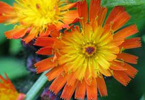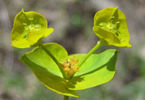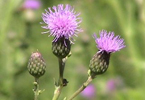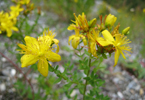Non-native plants: rooting out the invaders
What Parks Canada is doing / What can you do to help
Aliens are invading our national parks... not invaders from space, but plants! The plants have been introduced as a direct result of human activity over the past few decades, many arriving as accidental hitch-hikers. They may look harmless, but they disrupt natural ecosystem processes and threaten biodiversity.
Over 100 non-native plant species are found within Banff, Kootenay and Yoho national parks. Canada thistle, common toadflax, St. John's wort, leafy spurge, tall buttercup, tansy, and spotted knapweed are just some of the species of particular concern. These weeds are invasive, aggressive and spread at a rapid rate.



(left to right) Orange Hawkweed, Leafy Spurge, Canada Thistle, St. John's Wort
© Parks Canada
What Parks Canada is Doing
Parks Canada has adopted a non-native plant control program called integrated pest management. The goal of this program is to prevent the introduction of non-native plants, and to eliminate or control them, where practical, to maintain native plant and animal diversity. Even though it's much more effective to prevent the introduction of non-native weeds into national parks, once established, non-native plants must be eliminated or prevented from spreading further. Several means of plant control are used as part of the integrated pest management program:
Mechanical
Hand pulling, mowing and flower head removal are mechanical methods that weaken or remove non-native plants. However, for some invasive species these methods are not complete and may even stimulate growth in the remaining roots, causing an overall increase in weeds! Weed-specific ecological knowledge helps us tailor the timing and type of the controls to ensure the most effective results.
Biological
Biological control has been used in areas in Canada and the United States. Research shows promising results for using exotic insect species or bio-agents, such as beetles and flies that feed selectively on non-native plants. Domestic goats and sheep have also been used to control non-native plants.
At this time, biological control method have been used on provincial lands adjacent to Kootenay National Park (Stoddart Creek area) and are being considered as another tool for the national park weed control program. The use of domestic goats and sheep to control weeds inside national parks is not feasible due to the risks of introducing disease to native wildlife.
Chemical
Herbicides provide another option for invasive non-native plant control. Many herbicides are selective; they kill plants belonging to one group of plants while not harming plants belonging to another group. Herbicides reach weed seeds in the soil. Some of these seeds can remain viable for 75 years, so it is important to eliminate them!
We choose herbicides that effectively target the most invasive of plant species and have minimal risk to people, wildlife and park ecosystems. Even with these stringent guidelines, we limit spraying to areas of very dense or high numbers of highly invasive target species.
Management Actions
The following methods are being applied in Banff, Kootenay and Yoho national parks to control non-native weeds in both frontcountry (road accessible) and backcountry areas:
Prevention
- Weed free hay is used for government ranches and backcountry warden cabin pastures.
Control
- An integrated pest management plan guides the invasive non-native vegetation control program for Banff, Yoho and Kootenay national parks. First, we assess the ecology and location of the invasive species. Then, we choose the most appropriate and effective control method that poses the least risk to native species
- Hand picking efforts focus on several small sites within Banff, Kootenay and Yoho national parks.
- Canadian Pacific Railway’s invasive vegetation control program works to ensure rail safety and minimize invasive species.
Monitoring
- Non-native plant inventories are maintained and control sites are being monitored to evaluate the effectiveness of the program.
Restoration
- Guidelines are in place through the environmental assessment process and the park’s vegetation management program to guide reclamation of disturbed areas in Field and Lake Louise town-sites, back-country trails, highway corridors and other park locations. Local native plant species are the preferred choice. Reclamation action will incorporate mitigation for invasive non-native species.
What can you do to help fight weeds?
- Learn to identify invasive, non-native plants and report infestations in the national parks.
- If you travel with pack horses, carry only weed-free forage into the backcountry. Ensure horses are clean of weed seeds before entering the backcountry. (poop through)
- Avoid traveling and camping in weed infested areas to prevent weed seeds from spreading.
- Backcountry roads adjacent to national parks are also vectors that allow non-native plants to spread in remote areas. Wash your vehicle often if you travel these roads as seeds can be spread from one area to another through the mud and debris on your vehicle.
- If you are a landowner outside parks, take steps to control invasive, non-native plants on your property. The threat to native plant and animal diversity by invading non-native plants is not confined to national park ecosystems.
Related links
- Date modified :
